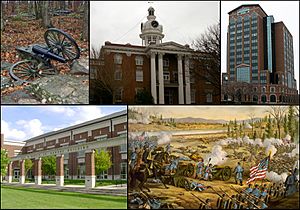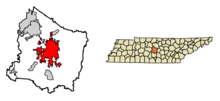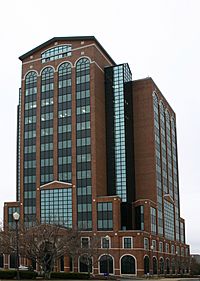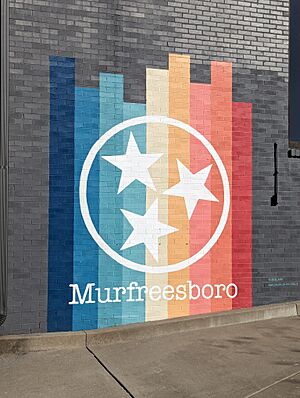Murfreesboro, Tennessee facts for kids
Quick facts for kids
Murfreesboro, Tennessee
|
|||
|---|---|---|---|

From top left, cannon at Stones River National Battlefield, Rutherford County Courthouse, City Center, MTSU's Paul W. Martin Sr. Honors Building, Battle of Stones River.
|
|||
|
|||
| Nickname(s):
"The 'Boro"
|
|||
| Motto(s):
Creating a better quality of life.
|
|||

Location of Murfreesboro in Rutherford County, Tennessee.
|
|||
| Country | |||
| State | |||
| County | Rutherford | ||
| Settled | 1811 | ||
| Incorporated | 1817 | ||
| Named for | Hardy Murfree | ||
| Government | |||
| • Type | Council–Manager | ||
| Area | |||
| • City | 64.13 sq mi (166.08 km2) | ||
| • Land | 63.99 sq mi (165.73 km2) | ||
| • Water | 0.14 sq mi (0.35 km2) 0.25% | ||
| Elevation | 610 ft (186 m) | ||
| Population
(2023)
|
|||
| • City | 165,430 | ||
| • Rank | US: 188th TN: 6th |
||
| • Density | 2,387.43/sq mi (921.79/km2) | ||
| • Urban | 350,000 (US: 241st) | ||
| Time zone | UTC−6 (CST) | ||
| • Summer (DST) | UTC−5 (CDT) | ||
| ZIP Codes |
37127-37133
|
||
| Area code(s) | 615, 629 | ||
| FIPS code | 47-51560 | ||
| GNIS feature ID | 1295105 | ||
| Website | City of Murfreesboro | ||
Murfreesboro is a city in Tennessee, USA. It's the main city in Rutherford County. In 2023, about 165,430 people lived here, a big jump from 2010. It's part of the greater Nashville area, about 34 miles (55 km) southeast of Nashville.
Murfreesboro was the state capital of Tennessee from 1818 to 1826. Today, it's the largest suburb of Nashville. It's also the sixth-biggest city in Tennessee. Murfreesboro is special because it's both the population center and the exact geographic center of Tennessee.
Since the 1990s, Murfreesboro has been Tennessee's fastest-growing big city. It's also one of the fastest-growing cities in the entire country! The city is home to Middle Tennessee State University (MTSU). MTSU is one of the largest universities for undergraduate students in Tennessee. In fall 2024, it had over 20,540 students.
Contents
History of Murfreesboro
On October 27, 1811, the Tennessee government chose this spot for a new county seat. They first named it Cannonsburgh. This was to honor Newton Cannon, a local representative. Later, on November 29, 1811, it was renamed Murfreesborough. This new name honored Colonel Hardy Murfree, a hero from the Revolutionary War. In January 1812, the name was shortened to Murfreesboro when the town officially became a city.
As more people moved west in Tennessee, the state capital in Knoxville became too far for many. So, in 1818, Murfreesboro was chosen as the new capital of Tennessee. The city grew very quickly! However, just eight years later, in 1826, Nashville became the capital instead.
The Civil War in Murfreesboro
On December 31, 1862, a major battle of the American Civil War happened near the city. It was called the Battle of Stones River, or the Battle of Murfreesboro. The Union Army fought against the Confederate Army. Over three days, from December 31 to January 2, 1863, both sides had many casualties. It was one of the bloodiest battles of the war for its size.
After the battle, the Union army needed a safe place for supplies. Murfreesboro was chosen for this important job. Soon after, a huge fort called Fortress Rosecrans was built. It covered about 225 acres (0.9 sq km) and was the largest fort built during the war. This fort helped the Union army move further south. Today, the Stones River National Battlefield is a national historical site. You can still see parts of the fort's walls there.
After the Civil War
Murfreesboro first grew as a farming community. By 1853, it had several colleges and schools. Even after the war, the town started to grow again in the early 1900s.
In 1911, the state opened Middle Tennessee State Normal School here. This school trained teachers. It later became Middle Tennessee State University (MTSU) in 1965. MTSU now has the most undergraduate students in Tennessee. Many students from other countries also study there.
During World War II, Murfreesboro started to develop more industries. It became a place for manufacturing and education. The city has grown steadily since then, creating a strong economy. Since the late 1990s, Murfreesboro has seen a lot of growth in homes and businesses. Its population more than doubled between 1990 and 2010. Many people from other countries, like Somalia and Iraq, have also made Murfreesboro their home.
Geography and Climate
Murfreesboro is located at 35°50′46″N 86°23′31″W / 35.846143°N 86.392078°W. The city covers about 64 square miles (166 sq km). Most of this area is land, with a small amount of water.
Murfreesboro is the exact geographic center of Tennessee. A stone monument marks this special spot. It's on Old Lascassas Pike, about 0.5 miles (0.8 km) north of MTSU.
The West Fork of the Stones River flows through Murfreesboro. There's a walking trail called the Greenway that follows the river. A smaller stream, Lytle Creek, runs through downtown.
Murfreesboro has natural and man-made lakes. It also has wetlands, like the Murfree Spring area.
The city has been hit by strong tornados several times. On April 10, 2009, a powerful tornado struck the edges of Murfreesboro. It caused a lot of damage and injured many people.
Climate in Murfreesboro
Murfreesboro has a humid subtropical climate. This means it has mild winters and hot, humid summers. The temperatures can range from very cold in winter to very hot in summer. For example, the record low was -19°F (-28°C) and the record high was 109°F (43°C). It rains a good amount throughout the year. Subtropical plants like Southern magnolia trees can grow here.
| Climate data for Murfreesboro, Tennessee (1991–2020 normals, extremes 1890–present) | |||||||||||||
|---|---|---|---|---|---|---|---|---|---|---|---|---|---|
| Month | Jan | Feb | Mar | Apr | May | Jun | Jul | Aug | Sep | Oct | Nov | Dec | Year |
| Record high °F (°C) | 78 (26) |
83 (28) |
89 (32) |
91 (33) |
97 (36) |
108 (42) |
108 (42) |
109 (43) |
107 (42) |
97 (36) |
87 (31) |
77 (25) |
109 (43) |
| Mean maximum °F (°C) | 68 (20) |
72 (22) |
79 (26) |
84 (29) |
89 (32) |
94 (34) |
96 (36) |
96 (36) |
94 (34) |
86 (30) |
78 (26) |
69 (21) |
98 (37) |
| Mean daily maximum °F (°C) | 47.9 (8.8) |
52.5 (11.4) |
61.1 (16.2) |
70.9 (21.6) |
79.0 (26.1) |
86.2 (30.1) |
89.2 (31.8) |
89.0 (31.7) |
83.8 (28.8) |
73.1 (22.8) |
60.9 (16.1) |
51.3 (10.7) |
70.4 (21.3) |
| Daily mean °F (°C) | 37.7 (3.2) |
41.4 (5.2) |
49.1 (9.5) |
58.3 (14.6) |
67.2 (19.6) |
75.3 (24.1) |
78.8 (26.0) |
77.8 (25.4) |
71.6 (22.0) |
59.9 (15.5) |
48.9 (9.4) |
41.2 (5.1) |
58.9 (14.9) |
| Mean daily minimum °F (°C) | 27.5 (−2.5) |
30.4 (−0.9) |
37.2 (2.9) |
45.7 (7.6) |
55.3 (12.9) |
64.4 (18.0) |
68.4 (20.2) |
66.6 (19.2) |
59.3 (15.2) |
46.7 (8.2) |
36.8 (2.7) |
31.0 (−0.6) |
47.4 (8.6) |
| Mean minimum °F (°C) | 9 (−13) |
13 (−11) |
20 (−7) |
29 (−2) |
39 (4) |
52 (11) |
59 (15) |
56 (13) |
43 (6) |
30 (−1) |
20 (−7) |
15 (−9) |
7 (−14) |
| Record low °F (°C) | −19 (−28) |
−16 (−27) |
2 (−17) |
19 (−7) |
32 (0) |
38 (3) |
47 (8) |
41 (5) |
33 (1) |
21 (−6) |
−3 (−19) |
−9 (−23) |
−19 (−28) |
| Average precipitation inches (mm) | 4.66 (118) |
4.87 (124) |
5.29 (134) |
4.83 (123) |
4.93 (125) |
5.68 (144) |
4.95 (126) |
3.61 (92) |
4.04 (103) |
3.46 (88) |
4.06 (103) |
5.54 (141) |
55.92 (1,420) |
| Average snowfall inches (cm) | 0.8 (2.0) |
0.7 (1.8) |
0.4 (1.0) |
0.0 (0.0) |
0.0 (0.0) |
0.0 (0.0) |
0.0 (0.0) |
0.0 (0.0) |
0.0 (0.0) |
0.0 (0.0) |
0.0 (0.0) |
0.3 (0.76) |
2.2 (5.6) |
| Average precipitation days (≥ 0.01 in) | 12.4 | 11.7 | 12.5 | 11.1 | 12.3 | 12.4 | 10.8 | 9.9 | 8.9 | 9.6 | 10.1 | 12.8 | 134.5 |
| Average snowy days (≥ 0.1 in) | 0.7 | 0.7 | 0.3 | 0.0 | 0.0 | 0.0 | 0.0 | 0.0 | 0.0 | 0.0 | 0.0 | 0.4 | 2.1 |
| Source: NOAA | |||||||||||||
People of Murfreesboro
| Historical population | |||
|---|---|---|---|
| Census | Pop. | %± | |
| 1850 | 1,917 | — | |
| 1860 | 2,861 | 49.2% | |
| 1870 | 3,502 | 22.4% | |
| 1880 | 3,800 | 8.5% | |
| 1890 | 3,739 | −1.6% | |
| 1900 | 3,999 | 7.0% | |
| 1910 | 4,679 | 17.0% | |
| 1920 | 5,367 | 14.7% | |
| 1930 | 7,993 | 48.9% | |
| 1940 | 9,495 | 18.8% | |
| 1950 | 13,052 | 37.5% | |
| 1960 | 18,991 | 45.5% | |
| 1970 | 26,360 | 38.8% | |
| 1980 | 32,845 | 24.6% | |
| 1990 | 44,922 | 36.8% | |
| 2000 | 68,816 | 53.2% | |
| 2010 | 108,755 | 58.0% | |
| 2020 | 152,769 | 40.5% | |
| 2023 (est.) | 165,430 | 52.1% | |
| Sources: U.S. Census Bureau U.S. Decennial Census |
|||
Population Changes
| Race / Ethnicity (NH = Not Hispanic) | Pop 2000 | Pop 2010 | Pop 2020 | % 2000 | % 2010 | % 2020 |
|---|---|---|---|---|---|---|
| White alone (NH) | 53,963 | 79,471 | 94,941 | 78.42% | 73.07% | 62.15% |
| Black or African American alone (NH) | 9,506 | 16,333 | 29,416 | 13.81% | 15.02% | 19.26% |
| Native American or Alaska Native alone (NH) | 173 | 292 | 398 | 0.25% | 0.27% | 0.26% |
| Asian alone (NH) | 1,841 | 3,628 | 5,748 | 2.68% | 3.34% | 3.76% |
| Pacific Islander alone (NH) | 15 | 43 | 90 | 0.02% | 0.04% | 0.06% |
| Some Other Race alone (NH) | 69 | 131 | 815 | 0.10% | 0.12% | 0.53% |
| Mixed Race or Multi-Racial (NH) | 819 | 2,404 | 7,443 | 1.19% | 2.21% | 4.87% |
| Hispanic or Latino (any race) | 2,430 | 6,453 | 13,918 | 3.53% | 5.93% | 9.11% |
| Total | 68,816 | 108,755 | 152,769 | 100.00% | 100.00% | 100.00% |
In 2020, Murfreesboro had 152,769 people living there. There were 52,530 households and 31,732 families.
In 2010, the city had 108,755 people. About 75% were White, and 15% were Black or African American. Other groups included Asian, Native American, and Pacific Islander people. About 6% of the population was Hispanic or Latino.
In 2000, about 30% of households had children under 18. The average household had 2.42 people. The median age in the city was 29 years old. This means half the people were younger than 29, and half were older.
Economy and Jobs
Murfreesboro has a strong and growing economy. Many different types of businesses are located here.
Major Employers
Here are some of the biggest employers in Rutherford County, where Murfreesboro is located:
| # | Employer | # of Employees |
|---|---|---|
| 1 | Nissan | 8,000 |
| 2 | Rutherford County government and schools | 6,482 |
| 3 | Middle Tennessee State University | 2,205 |
| 4 | National Healthcare | 2,071 |
| 5 | Ingram Content Group | 2,000 |
| 6 | State Farm Insurance | 1,650 |
| 7 | Amazon | 1,550 |
| 8 | St. Thomas Rutherford Hospital | 1,400 |
| 9 | Alvin C. York Veterans Administration Medical Center | 1,300 |
| 10 | Asurion | 1,250 |
The City Center building, also known as the Swanson Building, is the tallest building in Murfreesboro. It has 15 floors and is 211 feet (64 meters) tall. It holds offices for companies like Bank of America and National Healthcare Corporation (NHC).
Arts and Culture
Murfreesboro is a lively place with many arts and culture events.
Music Scene
The city hosts several music events each year.
- The Main Street Jazzfest happens every May.
- Uncle Dave Macon Days celebrates old-time music and dancing. This event has been going on for over 30 years. It includes national competitions for old-time music and dancing.
- Boro Fondo is a yearly music festival that also includes a bike tour and local artists.
Arts and Performances
The Murfreesboro Center for the Arts offers many shows. You can see exhibits, plays, concerts, dances, and magic shows there. Murfreesboro Little Theatre has been putting on plays since 1962.
The International FolkFest started in 1982. It happens every year in June. Groups from all over the world come to perform traditional songs and dances. They wear their special regional clothes.
Museums to Explore
- The Discovery Center at Murfree Spring is a nature center and museum for kids and families. It has 20 acres (8 hectares) of wetlands with different animals.
- Bradley Academy Museum shows items from the first school in Rutherford County. This school later became the only African American school in Murfreesboro.
- The Stones River National Battlefield is a national park. It remembers the Battle of Stones River from the Civil War. The park has a museum, a cemetery, monuments, and parts of Fortress Rosecrans.
- Oaklands Historic House Museum is a 19th-century mansion. It was important during the Civil War. Now it's a museum.
- Earth Experience: The Middle Tennessee Museum of Natural History opened in 2014. It's the only natural history museum in Middle Tennessee. It has over 2,000 items, including a full-size replica of a Tyrannosaurus rex skeleton!
Shopping and Downtown
Murfreesboro has two main shopping areas.
- Stones River Mall is an indoor mall with many stores and restaurants.
- The Avenue Murfreesboro is an outdoor shopping center.
The Historic Downtown Murfreesboro area also has many unique shops and places to eat. These are located around the old pre-Civil War Courthouse.
Parks and Recreation
Murfreesboro has many great parks and outdoor spaces for fun and relaxation.
- Cannonsburgh Village is like stepping back in time. It shows what a pioneer village looked like from the 1830s to the 1930s. You can see a grist mill, a school house, a doctor's office, and a wedding chapel. It's also home to the World's Largest Cedar Bucket!
- Old Fort Park is a 50-acre (20-hectare) park. It has baseball fields, tennis courts, a playground, and an 18-hole golf course. There are also picnic areas and a bike trail.
- Barfield Crescent Park is a large 430-acre (174-hectare) park. It has eight baseball fields, 7 miles (11 km) of biking and running trails, and an 18-hole disc golf course.
- Murfreesboro Greenway System is a network of paved paths. It has 12 miles (19 km) of trails and 11 starting points. The city plans to add many more miles of greenways and bikeways in the future.
Education in Murfreesboro
Murfreesboro has excellent schools for all ages.
- Elementary schools are managed by Murfreesboro City Schools (MCS). They focus on students from pre-kindergarten through sixth grade. The city has 12 MCS schools serving about 8,800 students.
- Secondary schools (middle and high schools) are overseen by Rutherford County Schools. This system has 50 schools and over 49,000 students.
- The Japanese Supplementary School in Middle Tennessee (JSMT) offers weekend Japanese education. Its classes are held at Middle Tennessee State University.
Media and News
Murfreesboro has several ways to get local news and entertainment.
Newspapers
- The Daily News Journal
- The Murfreesboro Post
- The Murfreesboro Pulse
- Sidelines – MTSU student newspaper
- Rutherford Source
Radio Stations
- WGNS – Talk radio
- WMOT – MTSU public radio station
- WMTS-FM – MTSU student-run station
- WRHW-LP - 3ABN Radio Christian
TV Channels
- City TV Murfreesboro, Channel 3 – A channel for local government news.
- MTN – MTSU student-run educational TV channel.
Transportation
Murfreesboro is easy to get to and from.
Air and Road Travel
For air travel, people use Nashville International Airport (BNA). There are also smaller airports nearby: Smyrna Airport (MQY) and Murfreesboro Municipal Airport (MBT).
Several major roads run through Murfreesboro. These include Interstate 24 and Interstate 840. Also, U.S. Routes 41, 70S, and 231 pass through the city.
Public Transportation
In 2007, Murfreesboro started its own public bus system called Rover. The buses are bright green and have a cartoon dog on the side! A ride costs $1.00 for adults and $0.50 for kids aged 6-16 and seniors. Kids under 6 ride for free. The buses run Monday to Friday.
Famous People from Murfreesboro
Many notable people have connections to Murfreesboro:
- Jerry Anderson (1953–1989), football player
- Ronnie Barrett (born 1954), firearms maker
- Rex Brothers (born 1987), Major League Baseball pitcher
- James M. Buchanan (1919–2013), economist
- Crystal Dangerfield (born 1998), WNBA basketball player
- Marisa Davila (born 1997), actress and singer
- Colton Dixon (born 1991), singer
- Corn Elder (born 1994), football player
- Bart Gordon (born 1949), politician
- Montori Hughes (born 1990), football player
- Muhammed Lawal (born 1981), mixed martial artist
- Sondra Locke (1944–2018), actress and director
- Jean MacArthur (1898–2000), wife of General Douglas MacArthur
- Bayer Mack (born 1972), filmmaker and journalist
- David Price (born 1985), Major League Baseball pitcher
- Grantland Rice (1880–1954), famous sportswriter and poet
- Margaret Rhea Seddon (born 1947), NASA astronaut
- Sarah Childress Polk (1803–1891), First Lady of the United States
- Barry Wilmore (born 1962), NASA astronaut
- Chris Young (born 1985), country music artist
Notable Bands from Murfreesboro
- Abated Mass of Flesh, brutal death metal
- Destroy Destroy Destroy, heavy metal
- De Novo Dahl, indie rock
- Feable Weiner, power pop
- Fluid Ounces, power pop
- Flummox, avant-garde metal
- Glossary, indie rock and roll/Americana
- The Katies, power pop
- The Plain, rock
- Self, alternative pop/rock
- The Tony Danza Tapdance Extravaganza, mathcore
- Velcro Stars, pop
Images for kids
See also
 In Spanish: Murfreesboro (Tennessee) para niños
In Spanish: Murfreesboro (Tennessee) para niños







